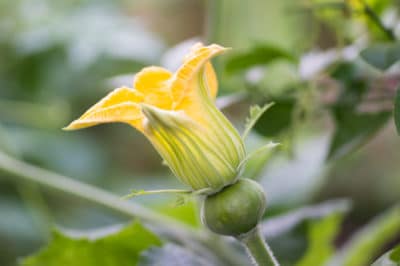Anatomy of a Watermelon Blossom
If you look at the flowers of plants in the Curbitaceae family, which includes watermelons, other melons, squash and cucumbers, you’d probably notice they all look similar. All produce yellow flowers that are perfect and either male or female.
- Male Flowers: Male watermelon flowers are the first to bloom. The stem that leads to the flower is thin, and the center of the flower is covered with small anthers filled with pollen and is devoid of any bulging.
- Female Flowers: Female flowers form after the males, their center contains a round-shaped stigma and a fuller undeveloped shape containing the unpollinated fruit. About every seventh flower is a female.
Seedless vs. Seeded Watermelon Flowers
The major difference between seeded and seedless varieties is the type of flower each plant produces. Seeded types produce both male and female blossoms, so pollination isn’t a problem. However, seedless plants produce only female flowers, thus an additional pollinator is required for fruit set.
Expert Tip: If growing a seedless watermelon, be sure to plant another hill or row of a variety producing seeds so its male blossoms pollinate the seedless variety’s flowers.
Blossom Development & Habits
After germination, it takes about 30 days for watermelon vines to begin blooming. Male flowers bloom first, appearing along the vines, with females blooming on the lateral shoots. Flowers bloom soon after sunrise and only stay open for one day, so it’s important for pollination to take place during this window of time.
Watermelon plants produce many more male and female flowers than will set fruit, so don’t be alarmed to see blossoms dropping. If your vines are about 10 feet long and you still haven’t seen any blossoms, pruning off the vine’s end makes it grow additional lateral shoots, where female flowers form.
Always use clean pruning tools when snipping off the watermelon vine’s end. You don’t want to transfer any disease to the plant. Wipe the blades off with alcohol.
The Importance of Pollination
If your watermelons plants are healthy, growing like gangbusters and blooming like crazy, the next important step in the flower’s lifecycle so it develops those lip-smacking, juicy melons is pollination. Without proper pollination, the female flowers won’t develop into fruits.
The little workhorses of nature, honeybees and native bees are the major pollinators of watermelon flowers. For complete pollination, it can take bees eight trips to a seeded variety’s flowers and 21 for a seedless type.
During times of bad weather, such as rainy, windy or cold conditions, the bee visits dwindle, thus the watermelon flowers might not receive proper pollination. If pollination of the flower is poor, it results in misshapen or small melons.
DIY Pollination
Whether due to bad weather or you don’t see many pollinators visiting your watermelon plants, and you feel pollination might be poor, you can help pollinate the blossoms yourself.
- Remove a male watermelon flower and dab it in the center of a female flower, transferring the pollen.
- You can also use a small artist’s paintbrush, rubbing it in the center of the male flower and then transfer the pollen to the center of a female watermelon flower.
You know pollination was successful if you see the bulge in the female flower growing and forming into a miniature watermelon.
